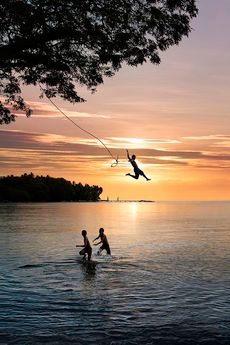The Halfway MarkHappy 4th of July weekend and welcome to the half way post for 2017. Summer affords us the chance to reflect and recreate. While enjoying a post dinner stroll, consider asking this: what did we learn in the first six months, and what does it mean? Our walks, conversations, and readings in the last 45 days have led to some learning in the areas of: leading yourself, your family, and your team at work. The Power of Productive Solitude What framework or structure have you set up for thinking? Where do you think best? Many people don’t know off hand, but after a minute or two might share that they think best when alone. We recently stumbled across a book on leading yourself, and have been enthralled from the very beginning. “Lead Yourself First” by Ray Kethledge and Mike Erwin is a qualitative study of how past leaders have used productive solitude to make key decisions. We are now 10 years into the era of having a super computer that is in your pocket. 1.2 billion Apple iPhones have been purchased, and our new behaviors around them are only just becoming understood. It could be stated that one of the outcomes we all feel is some sort of attachment to the devices. Just as the washing machine replaced the scrub board and freed up hours of our week, so has the super computer in our pocket made our lives easier. Amidst the ease might be another driver, in terms of connectivity to others as the home-run app; whether it is via text, email, or a social platform like Facebook. Belonging feels great. Counter to our need to belong is our need to be alone. This natural tension between autonomy and belonging has been dealing with a new actor for the past 10 years, and it appears that alone time is shrinking. We now have to choose to be alone, and “Lead Yourself First” comes along at an interesting time, making the case that in order to lead and make a contribution to others, you need to be able to think for yourself first. Which brings us back to our question of: what framework or structure do you have to allow you to collect your thoughts? If you have a free minute and enjoy this topic, please share with us here how you build your thoughts to make key decisions.  HAGS The school yearbooks came home the other day with both kids smiling from ear to ear and ready to show us all the wonders within. Thirty years have passed since that bound accumulation of all our relationships, both good and bad, were in our backpacks, and it was pleasing to see that it still held its attraction with today’s youth. Inside the cover amidst the longer messages from the good friends was an abbreviation that has stood the test of time. H.A.G.S. As adults helping guide the family through life, the notion of having a great summer has a different connotation. It comes down to making sure you have a summer at all, that you can stand there on Labor Day and say, yes we actually had a summer and it was great! We took the time to get away and let rashes and skinned knees appear and even allow some wondering and boredom to present themselves. Making a contribution to your family's great summer is a curious challenge no matter what your role. We doubt it will require great amounts of funds or an amazing destination, it may just be instituting a regular game of cards or figuring out which board game everyone enjoys playing. Whatever you choose, having a great summer leads to a fantastic fall, so try and do something different and distinctively unique this season. If you were headed back to school, after this summer would you be able to write an epic edition of that timeless teacher faithful, “what did you do this summer?”  The Consequences of Mediocrity One of the major headwinds to a great summer is if you are only 50% of the way to your annual goal by now, you are actually behind the number, because you will lose ground in Q3, and may not have the time to catch up in Q4. Being below goal is not a happy place, and could even be considered mediocre. If you are the leader it is easy to blame your people, but in a recent article by Joseph Grenny he articulates why it might be the leader's fault, and he shares a couple of ways to bring the big middle of your team up a few notches. Grenny is the co-author of one of our favorite books “Crucial Conversations, tools for talking when the stakes are high”. In this article he wrote for the Harvard Business Review he shares several ways to help the team visualize what their indifference could cause. We think this hits the spot when it comes to larger group activities. The big middle is too easily swayed by the 'who cares' crowd, and the costs to change the bias by those in the middle is too great socially. As a consequence, a status quo of “slow it down” vs. “pick it up” is established. The ability to stimulate a “let’s pick up the pace” mindset rests with the leader, and Grenny shows us how to tease out the inner hard worker in your workforce. No one wants to be average, and yet by rule there always is an average. However one of the synonyms for mediocre is the word forgettable, and seldom seen is the human who when presented with the option of being remembered or being forgotten won’t choose the former. Once convinced and bought in on being remembered, the leader then shows and teaches the tangible steps and behaviors that lead to success. Pretty soon your group may start acting like a team, and as the leader you may start to feel that surge that comes when humans care together at scale. Like all people puzzles it may be hard, but it’s worth it. H.A.G.S
0 Comments
Leave a Reply. |
Archives
November 2023
Categories
All
Complete Annual Newsletter Volumes
|

